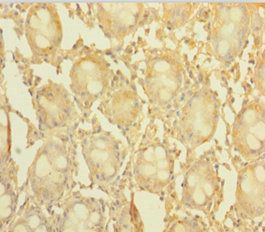CCDC94 Antibody
-
货号:CSB-PA866295LA01HU
-
规格:¥440
-
促销:
-
图片:
-
其他:
产品详情
-
产品名称:Rabbit anti-Homo sapiens (Human) CCDC94 Polyclonal antibody
-
Uniprot No.:Q9BW85
-
基因名:CCDC94
-
别名:YJU2 antibody; CCDC94Splicing factor YJU2 antibody; Coiled-coil domain-containing protein 94 antibody
-
宿主:Rabbit
-
反应种属:Human
-
免疫原:Recombinant Human Coiled-coil domain-containing protein 94 protein (1-279AA)
-
免疫原种属:Homo sapiens (Human)
-
标记方式:Non-conjugated
本页面中的产品,CCDC94 Antibody (CSB-PA866295LA01HU),的标记方式是Non-conjugated。对于CCDC94 Antibody,我们还提供其他标记。见下表:
-
克隆类型:Polyclonal
-
抗体亚型:IgG
-
纯化方式:>95%, Protein G purified
-
浓度:It differs from different batches. Please contact us to confirm it.
-
保存缓冲液:Preservative: 0.03% Proclin 300
Constituents: 50% Glycerol, 0.01M PBS, PH 7.4 -
产品提供形式:Liquid
-
应用范围:ELISA, IHC
-
推荐稀释比:
Application Recommended Dilution IHC 1:20-1:200 -
Protocols:
-
储存条件:Upon receipt, store at -20°C or -80°C. Avoid repeated freeze.
-
货期:Basically, we can dispatch the products out in 1-3 working days after receiving your orders. Delivery time maybe differs from different purchasing way or location, please kindly consult your local distributors for specific delivery time.
相关产品
靶点详情
-
功能:Part of the spliceosome which catalyzes two sequential transesterification reactions, first the excision of the non-coding intron from pre-mRNA and then the ligation of the coding exons to form the mature mRNA. Plays a role in stabilizing the structure of the spliceosome catalytic core and docking of the branch helix into the active site, producing 5'-exon and lariat intron-3'-intermediates. May protect cells from TP53-dependent apoptosis upon dsDNA break damage through association with PRP19-CD5L complex.
-
亚细胞定位:Nucleus.
-
蛋白家族:CWC16 family
-
数据库链接:
HGNC: 25518
KEGG: hsa:55702
STRING: 9606.ENSP00000262962
UniGene: Hs.21811
Most popular with customers
-
YWHAB Recombinant Monoclonal Antibody
Applications: ELISA, WB, IF, FC
Species Reactivity: Human, Mouse, Rat
-
Phospho-YAP1 (S127) Recombinant Monoclonal Antibody
Applications: ELISA, WB, IHC
Species Reactivity: Human
-
-
-
-
-
-























